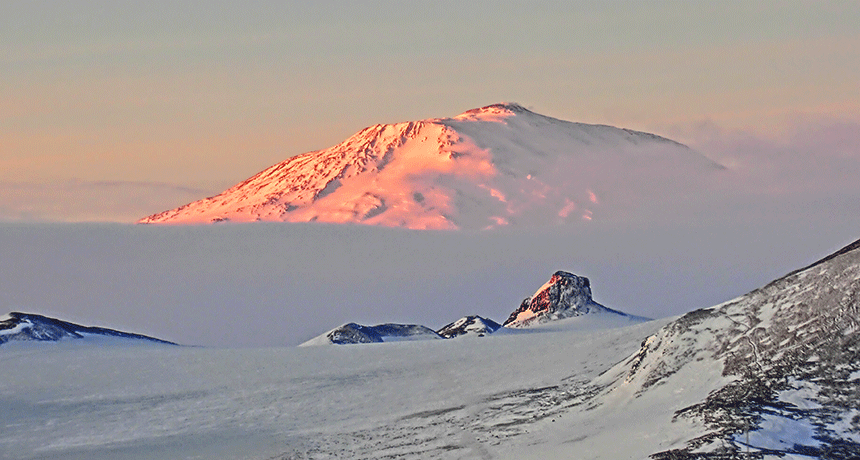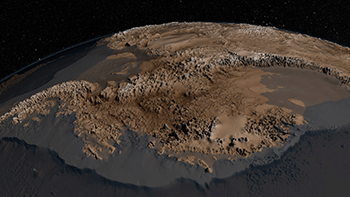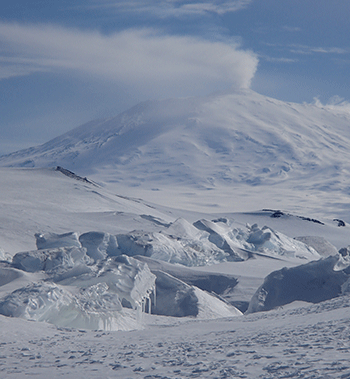Giant volcanoes lurk beneath Antarctic ice
The expanse of buried volcanoes raises questions about the future of the ice sheet

Mount Erebus, the world’s southernmost active volcano, rises 3,794 meters (12,477 feet) above the ice in Antarctica. It’s in the same region as the newly discovered buried volcanoes.
Steve Rupp/National Science Foundation
By Beth Geiger
Lurking beneath Antarctica’s ice are 91 volcanoes that until now no one knew existed. This may be one of the most extensive volcanic regions on Earth. The discovery isn’t, however, just a fun factoid about the planet’s southernmost continent. It’s got scientists wondering just how active these volcanoes are. For instance, their volcanic heat might speed the shrinking of Antarctica’s already endangered ice.
Max Van Wyk de Vries is an undergraduate geology student at the University of Edinburgh in Scotland. He was curious about what Antarctica looked like under all its ice. He found data on the internet that described the underlying land. “I wasn’t really looking for anything in particular when I first started,” he recalls. “I was just interested in seeing what the land looked like under the ice.”
But then, he says, he started seeing familiar-looking cone shapes. Lots of them. Cone shapes, he knew, are typical of volcanoes. He looked more closely. Then he showed them to Andrew Hein and Robert Bingham. Both are geologists at his school.
Together, they confirmed what Van Wyk de Vries thought he saw. These were 91 new volcanoes hiding beneath ice as much as 3 kilometers (1.9 miles) thick.
Some peaks were large — up to 1,000 meters (3,280 feet) high and tens of kilometers (at least a dozen miles) across, says Van Wyk de Vries. “The fact that there was a large number of undiscovered volcanoes in Antarctica that had escaped attention was honestly surprising to all of us, especially given that many of them are huge,” he notes. Small bumps on the ice mark the site of some buried volcanoes, he says. No surface clues, however, reveal the existence of most of them.
The team described its findings last year in a Geological Society of London Special Publication.
Volcano hunters
Previous scientific studies in the area had focused on the ice. But Van Wyk de Vries and his colleagues looked instead at the land surface beneath the ice. They used an online data set called Bedmap2. Created by the British Antarctic Survey, it combines different types of data about Earth. One example is ice-penetrating radar, which can “see” through the ice to reveal the shape of the land below.

The geologists then cross-checked the cone shapes they had spotted with Bedmap2 against other types of data. They used several methods that can help confirm the presence of a volcano. For example, they studied data showing the density and magnetic properties of the rocks. These can give scientists clues to their type and origins. The researchers also looked at images of the area taken by satellites. In all, 138 cones matched all of the criteria for a volcano. Of those, 47 had been identified earlier as buried volcanoes. That left 91 as brand new to science.
Christine Siddoway works at Colorado College in Colorado Springs. Although she studies Antarctic geology, she did not take part in this project. The new study is a great example of how online data and images can help people make discoveries in inaccessible places, Siddoway now says.
These volcanoes are hidden beneath the vast, slowly moving West Antarctic Ice Sheet. Most lie in a region called Marie Byrd Land. Together, they form one of the planet’s largest volcanic provinces, or regions. This newfound province stretches across a span as large as the distance from Canada to Mexico — some 3,600 kilometers (2,250 miles).
This mega-volcanic province is likely associated with the West Antarctic Rift zone, explains Bingham, an author of the study. A rift zone forms where some of the tectonic plates of Earth’s crust are spreading or splitting apart. That allows molten magma to rise toward Earth’s surface. That in turn can feed volcanic activity. Many rifts around the world — such as the East African Rift zone — have been linked with active volcanoes.
Lots of molten magma marks a region that could produce plenty of heat. Just how much, though, is not yet known. “The West Antarctic Rift is by far the least known of all of Earth’s geologic rift systems,” notes Bingham. The reason: Like the volcanoes, it’s buried beneath thick ice. In fact, no one is even sure how active the rift and its volcanoes are. But it is surrounded by at least one gurgling, active volcano sticking above the ice: Mount Erebus.
Van Wyk de Vries suspects the hidden volcanoes are pretty active. One clue is that they are still cone-shaped. The West Antarctic Ice Sheet is slowly sliding toward the sea. Moving ice can erode underlying landscapes. So if the volcanoes were dormant or dead, the moving ice would have erased or deformed that characteristic cone shape. Active volcanoes, in contrast, constantly re-build their cones.
Volcanoes + ice = ??
If this region hosts a lot of live volcanoes, what might happen if they interact with the ice above them? The scientists don’t yet know. But they describe three possibilities in their study.
Perhaps the most obvious one: Any eruptions could melt the ice sitting above. With Earth’s climate warming, melting Antarctic ice is already a huge concern.
Melting ice raises sea levels around the globe. The West Antarctic Ice Sheet is already crumbling around its edges, where it floats on the sea. In July 2017, for example, a chunk of ice the size of Delaware broke off and drifted away. (That ice didn’t raise sea levels, because it was sitting on top of water. But its loss makes it easier for ice on land to flow into the sea where it would raise sea levels.) If the whole West Antarctic sheet melted, sea level would rise at least 3.6 meters (12 feet) worldwide. That’s enough to flood most coastal communities.

Individual eruptions, though, probably wouldn’t have much effect on the whole ice sheet, says Van Wyk de Vries. Why? Each would be just one small point of heat under all that ice.
If the whole volcanic province is active, however, that would create a different story. High temperatures over a large region would melt more of the base of the ice. If the melt rate was high enough, it would carve channels along the bottom of the ice sheet. Flowing water in those channels would then act as a powerful lubricant to speed the ice sheet’s motion. Faster sliding would send it out to sea sooner, where it would melt even faster.
Measuring temperatures at the base of an ice sheet is quite hard, notes Van Wyk de Vries. So it’s hard to tell how warm the volcanic province is, beneath all that ice.
A second possible impact of all of those volcanoes is that they might actually slow the flow of ice. Why? Those volcanic cones make the land surface under the ice bumpier. Like speed bumps in a road, those cones might slow the ice, or tend to “pin” it in place.
A third option: Ice thinning due to climate change might work to trigger more eruptions and ice melting. Ice is heavy, Bingham notes, which serves to weigh down Earth’s rocky crust below. As an ice sheet thins, that pressure on the crust would diminish. This reduced pressure might then “uncap” magma inside the volcanoes. And that could trigger more volcanic activity.
This has, in fact, been seen on Iceland. And there is evidence it could happen in Antarctica too, Bingham adds. It looks like exposed volcanoes like Mount Erebus erupted more often after the last ice age, when the ice thinned. Van Wyk de Vries thinks we can expect a repeat. “This almost certainly will happen as the ice melts,” he says.
But exactly what will happen, and where, is complicated, he adds. Buried volcanoes may behave differently in different parts of the ice sheet. Researchers may find all three effects — melting, pinning and erupting — at different spots. That will make predicting the overall impacts especially tough. But at least now scientists know where to look.







